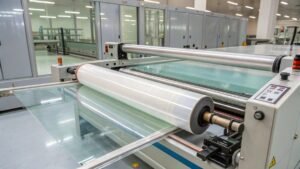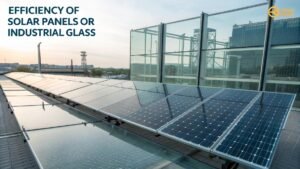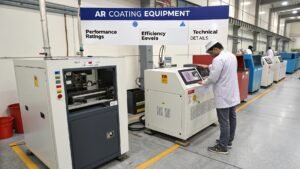Glass manufacturers face growing pressure to deliver high-performance, energy-efficient glass while keeping production efficient and environmentally compliant. The right equipment can be the difference between innovation and stagnation.
Glass coating equipment applies specialized nano-layers on glass surfaces to enhance performance properties like UV resistance, thermal insulation, solar control, or aesthetic finishes. It uses technologies like roll coating, spray systems, or vacuum deposition.
Whether you're building solar glass or architectural façades, understanding how these machines function will help you make smarter investments.
Why is glass coating equipment important for modern glass manufacturing?
Rising energy costs and green building standards are reshaping the glass industry. Manufacturers now need equipment that delivers efficiency, compliance, and high-performance coatings in one seamless solution.
Glass coating equipment allows manufacturers to apply functional layers—like anti-reflective or thermal insulation coatings—on glass with precision and consistency. This helps meet performance demands in architecture, solar, and automotive sectors.
Coated Glass Is No Longer Optional
Coated glass has become a standard requirement across industries. Architectural projects demand low-E or IR-reflective glass to boost energy performance. Solar panel manufacturers require consistent coatings like Perovskite Coating for Solar Panels or Thin Film CdTe PV Technology to ensure panel efficiency.
That’s why at Glass Coat, we design our Industrial Glass Coating Machines with modularity, durability, and precision in mind. The goal is not just to coat glass, but to add measurable value to every piece.
How does glass coating equipment work step by step?
There’s a lot of mystery around how these machines apply coatings so evenly. Let’s break it down in a simple, transparent way.
Glass coating equipment starts by cleaning and prepping glass sheets. Then, a coating method—roll, spray, or vacuum—is applied. Finally, curing or annealing systems ensure strong adhesion and functional performance.
Step-by-Step: From Raw Glass to Coated Performance
1. Pre-treatment and Cleaning
Every coating line starts with a glass washing and drying station. Clean surfaces ensure better coating adhesion. High-speed brushes and deionized water remove particles or oils.
2. Coating Application
| Coating Method | Description | Best Used For |
|---|---|---|
| Roll Coating | Uses precision rollers to spread liquid coatings evenly | Decorative and functional coatings |
| Spray Coating | Atomizes coating onto the glass using spray nozzles | IR/UV shielding, decoration |
| Vacuum Deposition | Applies thin-film coatings in a vacuum chamber | Low-E glass, solar coatings |
Our clients in solar production often choose vacuum systems, while Roll Coating for Glass Industry remains popular for decorative and UV/IR-blocking glass.
3. Curing or Annealing
Once coated, the glass goes through high-temperature ovens or UV curing systems. For example, our R-COATING Perovskite Technology ensures optimal curing of solar-active coatings.
This step secures the film on the glass and activates performance properties like hardness, solar reflectivity, or chemical resistance.
What types of coatings can be applied using glass coating machines?
Each industry demands different performance from glass. The right coating equipment can be configured to apply layers that match those needs—whether it’s energy efficiency or aesthetic appeal.
Glass coating machines can apply solar-reflective coatings, thermal insulation layers, anti-reflective films, decorative paints, and more. Each application improves the glass's function in real-world environments.
Matching Coatings to Application Needs
| Coating Type | Function | Common Application |
|---|---|---|
| Low-E Coatings | Reflects heat, retains indoor temperature | Architectural glass |
| UV/IR Coatings | Blocks harmful rays | Automotive and building glass |
| Anti-Reflective Coatings | Increases light transmission | Photovoltaic Glass |
| Decorative Paint/Print | Adds design and branding | Interior design, signage |
| Perovskite/Solar Coating | Converts light into electricity | Solar panels |
In my experience, one of the fastest-growing demands comes from solar glass manufacturers. They are investing heavily in high-precision coaters, particularly for Perovskite and CdTe technologies. We’ve developed solutions like Anti-Reflective Coating for Photovoltaic Glass to serve this need globally.
What are the key components of a glass coating line?
If you're sourcing coating equipment, it's critical to understand what makes up a full coating line. It’s not just one machine—it’s a connected system built for performance and uptime.
A full glass coating line includes washing units, coating applicators (roller/spray/vacuum), drying/curing zones, control systems, and often, Automatic Glass Packing Systems.
Breaking Down the Equipment
Core Modules of a Coating Line:
- Glass Washer – Cleans contaminants before coating.
- Coating Module – Applies liquid or vacuum-based layers.
- Drying/Curing Zone – Fixes the coating with thermal or UV energy.
- Conveyor and Transfer System – Moves glass with synchronized flow.
- Inspection & Control Unit – Monitors thickness, uniformity, and quality.
- Packing Station – Our High-Performance Glass Packaging Line ensures safety and automation post-production.
These components work in sync to maximize throughput, reduce downtime, and ensure repeatable quality.
How do I choose the right glass coating equipment for my business?
Choosing equipment isn’t just about specs—it’s about fit. Your production goals, space, and market focus should all guide your decision.
Select glass coating machines based on your application needs, desired throughput, line space, and ROI expectations. Look for scalable systems with strong after-sales support.
What I Tell My Clients
I always ask: “What problem are you trying to solve with this coating?” That defines everything else.
Key Decision Points:
- What performance do you need? IR-blocking? Decorative? Power-generating?
- How much glass do you process daily? Choose your automation level accordingly.
- What’s your space and energy availability? Compact or high-load systems may be needed.
- What’s your market? Glass Coating Machinery for Solar and Coating Equipment for Building Glass differ greatly.
Also, prioritize service. At Glass Coat, we work closely with procurement teams to customize equipment, offer remote support, and train your operators for long-term success.
If you're exploring coating lines and need more technical insights or cost benchmarks, I recommend checking data from Glass Magazine or PV Tech for solar-related coating trends.
For more solutions on nano-coating, decorative finishes, or high-volume solar glass, visit our homepage at https://glscoat.com





